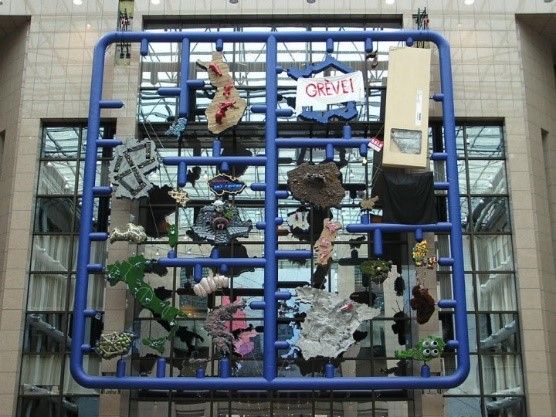Entropa sculpture: Stereotypes are barriers that need to be removed (David Černý, 2009) Source.

Entropa sculpture: Stereotypes are barriers that need to be removed (David Černý, 2009). Source: davidcerny.cz/start.html
What do we see?
To start its first presidency of the EU in 2009, the Czech Republic commissioned the Czech artist David Černý, to produce a work of art for the entrance lobby of the European Parliament in Brussels. The eight-ton sculpture, called ‘Entropa’, was aptly subtitled “Stereotypes are barriers that need to be removed”. The artistic creation consists of a large plastic frame (16×16 metres) that carries the shapes of the 27 member states of the EU. The entire sculpture resembles a mass-produced product, where the individual components (countries) are supposed to be removed from the plastic mould and assembled into the final product (the EU). The countries are, thus, conceptualized as ready-made pieces for a puzzle.
The artistic representations of the states draw on some preconceived notions associated with the individual countries. They range from relatively positive (Belgium as a half-eaten box of chocolates) and neutral (Sweden as an Ikea box with the Gripen aircraft inside) to less positive (Spain covered up by concrete), but also vulgar (Italy – fornicating footballers) and even downright offensive (Bulgaria with a Turkish toilet). In many cases, the humorous representations have some factual basis reflecting the reality in the particular countries (e.g., frequent striking action in France, the renouncement of atomic energy in Austria, overtourism in Spain). At other times, they leave ample open space for interpretation (Finland with exotic animals).
In several national representations, potentially sensitive issues are introduced. In the case of Poland, for instance, we see priests raising the LGBT rainbow flag in a potato field, in a scene borrowed from the canonical photograph of soldiers raising the US flag over Iwo-Jima (see Figure 2). However, meaning in Entropa is also communicated by what we do not see: instead of the UK sculpture, there is a missing place in the frame, referencing the country’s ambivalent position towards the EU (which was eventually to lead to Brexit a few years later on).
What public issue is being addressed here?
The use of national stereotypes is an omnipresent feature of humour (e.g. the stinginess of the Scots) – humour very often relies on the construction of the opposing groups of ‘us’ and ‘them’, both within national boundaries and internationally, reflecting both the tensions inside a particular country (e.g. the city vs. country dichotomy) and between individual countries (cf. Davies 2010, 2011). Entropa reveals some of the often unpleasant stereotypes that people hold about other cultures, which may be subject to ridicule and various forms of humour. In some cases, such stereotypes include politically and culturally sensitive issues that may be found embarrassing and offensive. However, the aim of this piece of art is not to mock the other cultures but, rather, to provoke and stimulate critical self-reflection on ‘us’ and ‘others’. On another level, the word play in the title of the sculpture appears to allude to ‘entropy’ (i.e., the lack of order or the gradual decline into chaos), thus possibly forcing us to also consider the fragile stability of the EU, with all its integrating and disintegrating tendencies.
What does the humour do?
The sculpture is the result of the artist’s mystification of the public authorities (since it was originally commissioned as a work with contributions from artists from all the 27 countries), and his semiotic play involving national stereotypes and implicit socio-political commentary. Described by the artist as a grotesque exaggeration, the tongue-in-cheek work is not only provocative but it also stirred some international controversy. Although many found it funny and amusing, others protested: Slovakia objected against being shown as a Hungarian salami and Bulgaria even officially asked for its negative representation to be removed. Yet, Entropa forces the viewers to reflect critically on national stereotypes: art and humour are used here not for entertainment but in order to open up the debate about the entrenched notions that we – as private individuals as state citizens – hold about other cultures, often on the basis of superficial tourist knowledge or even no personal experience at all. When countering some of the negative reception of the work, the artist explained that “we do not want to offend anybody; we just want to point out the difficulty of communicating whenever one is incapable of being ironic”. (davidcerny.cz/start.html).
Bibliography
Davies, Christie (2010) The Mirth of Nations. Transaction Publishers.
Davies, Christie (2011) Jokes and Targets. Bloomington: Indiana University Press.

Stereotypical representation of Poland: Agriculture, Catholic priests and LGBT
